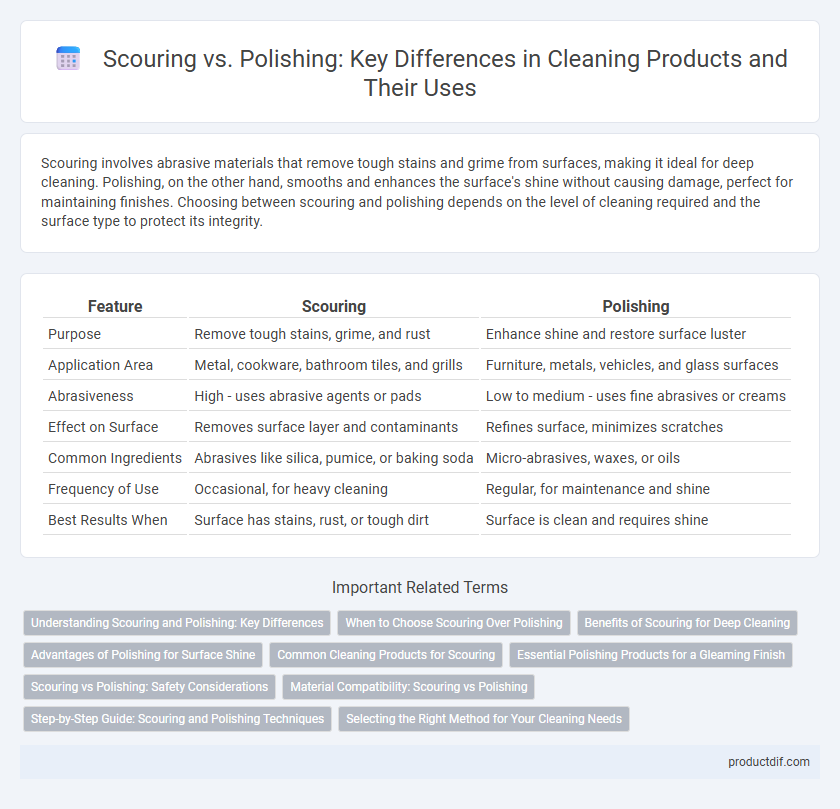Scouring involves abrasive materials that remove tough stains and grime from surfaces, making it ideal for deep cleaning. Polishing, on the other hand, smooths and enhances the surface's shine without causing damage, perfect for maintaining finishes. Choosing between scouring and polishing depends on the level of cleaning required and the surface type to protect its integrity.
Table of Comparison
| Feature | Scouring | Polishing |
|---|---|---|
| Purpose | Remove tough stains, grime, and rust | Enhance shine and restore surface luster |
| Application Area | Metal, cookware, bathroom tiles, and grills | Furniture, metals, vehicles, and glass surfaces |
| Abrasiveness | High - uses abrasive agents or pads | Low to medium - uses fine abrasives or creams |
| Effect on Surface | Removes surface layer and contaminants | Refines surface, minimizes scratches |
| Common Ingredients | Abrasives like silica, pumice, or baking soda | Micro-abrasives, waxes, or oils |
| Frequency of Use | Occasional, for heavy cleaning | Regular, for maintenance and shine |
| Best Results When | Surface has stains, rust, or tough dirt | Surface is clean and requires shine |
Understanding Scouring and Polishing: Key Differences
Scouring involves abrasive materials or agents that physically remove dirt, grime, and stains from surfaces, making it ideal for heavy-duty cleaning tasks. Polishing, on the other hand, smooths and enhances the surface's shine by using fine abrasives or chemical agents, focusing on finishing rather than deep cleaning. Understanding these differences helps in selecting the right product for either surface restoration or maintaining a glossy finish.
When to Choose Scouring Over Polishing
Scouring is the ideal choice for removing tough stains, grime, and baked-on food residues from surfaces like pots, pans, and countertops, where abrasive action is necessary. It works effectively on durable materials such as stainless steel, ceramic, and glass without causing significant damage. Polishing, by contrast, is best suited for enhancing shine and removing minor surface imperfections rather than heavy-duty cleaning.
Benefits of Scouring for Deep Cleaning
Scouring effectively removes tough stains, grease, and grime from surfaces by using abrasive particles that reach into microscopic crevices, unlike polishing which primarily enhances shine. This deep cleaning method restores surface texture, preparing materials for further treatment or maintenance. Scouring's ability to eliminate embedded dirt ensures a more thorough cleanse, prolonging the lifespan of kitchenware, countertops, and bathroom fixtures.
Advantages of Polishing for Surface Shine
Polishing enhances surface shine by creating a smooth, reflective finish that scouring cannot achieve without risking abrasion. It seals microscopic pores, reducing dirt buildup and making surfaces easier to maintain. Polishing also restores the original luster of materials like metal, wood, and stone, significantly improving aesthetic appeal.
Common Cleaning Products for Scouring
Common cleaning products for scouring include abrasive powders, creams, and pads designed to remove tough stains, grime, and baked-on residues from surfaces without causing damage. Ingredients like calcium carbonate, silica, and oxalic acid are frequently used in scouring agents to enhance their effectiveness in scrubbing metal, ceramic, and glass surfaces. These scouring products are essential for deep cleaning tasks and preparation before polishing to achieve a spotless and smooth finish.
Essential Polishing Products for a Gleaming Finish
Essential polishing products for a gleaming finish include high-quality polishing compounds, soft microfiber cloths, and specialized buffers designed to enhance surface shine without causing scratches. Unlike scouring products that rely on abrasive materials to remove tough grime and stains, polishing products focus on refining and protecting surfaces to restore their natural luster. Using a combination of fine polishing agents and proper application tools ensures a smooth, reflective finish on metals, glass, and painted surfaces.
Scouring vs Polishing: Safety Considerations
Scouring products often contain abrasive particles that can scratch surfaces and cause skin irritation, requiring users to wear gloves and avoid contact with sensitive materials. Polishing products typically have chemical agents designed to enhance shine without heavy abrasion but may emit fumes that necessitate proper ventilation. Understanding the safety considerations of scouring versus polishing ensures effective cleaning while minimizing health risks and surface damage.
Material Compatibility: Scouring vs Polishing
Scouring products, typically abrasive, effectively remove tough stains and grime but may damage delicate surfaces like glass, stainless steel, or polished wood due to their rough texture. Polishing products use finer abrasives or chemical agents designed to enhance shine and smoothness, making them suitable for sensitive materials such as marble, chrome, or varnished surfaces without causing scratches. Choosing between scouring and polishing depends on the material compatibility to prevent surface degradation while achieving optimal cleanliness and finish.
Step-by-Step Guide: Scouring and Polishing Techniques
Scouring involves abrasive materials like powders or pads to remove tough stains, rust, or grime by applying firm pressure in circular motions. Polishing uses finer abrasives or creams to smooth surfaces and enhance shine, typically with soft cloths or buffers in gentle, consistent strokes. Following these techniques sequentially--scouring first to clean and polish second to finish--ensures optimal restoration and luster for metal, wood, or stone surfaces.
Selecting the Right Method for Your Cleaning Needs
Scouring effectively removes tough stains and grime from durable surfaces like metal and ceramic through abrasive action, while polishing enhances shine and smoothness on finished surfaces such as wood or glass by creating a fine, smooth layer. Selecting the right cleaning method depends on surface sensitivity and desired outcome; use scouring for heavy-duty cleaning and polishing for maintaining or restoring surface luster. Properly matching the technique ensures optimal cleanliness without damaging the material.
Scouring vs Polishing Infographic

 productdif.com
productdif.com